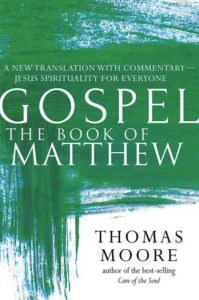Gospel—The Book of Matthew: A New Translation with Commentary—Jesus Spirituality for Everyone
Reviewed by Rob Pierson
June 1, 2017
 Translated by Thomas Moore. Skylight Paths Publishing, 2016. 224 pages. $29.99/hardcover; $19.99/paperback; $19.95/eBook.
Translated by Thomas Moore. Skylight Paths Publishing, 2016. 224 pages. $29.99/hardcover; $19.99/paperback; $19.95/eBook.
Buy from QuakerBooks
The other day over lunch, I told a friend that I had been asked to review the Gospel of Matthew. He promptly snorted his soup and started laughing. “What? Are you going to say ‘It’ll never sell’?”
He has a point. Even if I’m really reviewing a new translation of the Gospel of Matthew, there’s 2,000 years of history crowding into the room. What can we say that’s truly fresh and new?
Thomas Moore, former monk, psychotherapist, and author of Care of the Soul, hopes to revive the gospels for an age of spirit (though not religion). Jesus, says Moore, “wanted to raise human awareness and behavior to another level.” His Gospel—The Book of Matthew attempts to transmit this “Jesus spirituality for everyone.”
Let’s just admit right away that a “spirituality for everyone” won’t appeal to everyone. In his commentary, Moore unmoors the Gospel from its historical and religious anchors, recasting Jesus into a timeless “spiritual poet,” God into “the secret ways of the cosmos,” and “The Holy Spirit” into “a holy spirit” (which, by the way, is quite correct as an alternate translation). Specific messianic hopes and apocalyptic fears in Roman-occupied Judea are eclipsed by a universal personal psychology.
For example, for Moore, the apocalyptic day of judgment happens “right now [when] you are judged by your own decisions. No one else is condemning or rewarding you.” Likewise, when Jesus says he has come not to get rid of the law (i.e. the Torah) but to complete it (Matt. 5:17), Moore notes that “the Gospels can help you find deeper meaning in your traditions, whatever they are.”
Moore’s book is two books in one—Gospel translation on right-hand pages, commentary on the left. In the commentary, Gospel passages trigger free associations with anything from Carl Jung to Leonard Cohen. Some footnotes range beyond eclectic to odd. I’m still trying to figure out how Moore relates Jesus’s sensuality to the beheading of John the Baptist.
However, in the Gospel itself, many of Moore’s translation choices illuminate and enliven what has become, for many, a brittle, faded manuscript. Moore replaces time-worn and doctrine-laden phrases like “heaven,” “faith,” “sin,” and “repentance” with stripped down (but faithful) translations. For example, “sin” becomes “tragic mistakes,” and “repentance” becomes the kind of deep change that averts these tragic mistakes. “Faith” is rendered as “trust.” “Trust more” becomes Jesus’s persistent refrain for entering life in the kingdom.
Moore also emphasizes concrete symbols at the core of the Gospel—“bread,” for example, as symbol of what is truly essential. More startlingly, Moore replaces “heaven” (an increasingly abstract concept) with its most basic translation, “sky.”
“Turn your life around,” proclaims John the Baptist, “The era of the sky father is drawing near!” (Matt. 3:2).
Recovering the word “sky” works well in Matthew 16. The Pharisees and Sadducees demand a sign from heaven—literally “from the sky.” Jesus replies that they know perfectly well how to interpret the literal sky but seem blind to signs from the symbolic sky.
“It is my conviction,” writes Moore, “that the less literally you take most passages, the more you will be inspired to live an altogether different kind of life.” And later on, “You have to think in layers and metaphors.”
There are occasional strange missteps in the translation. For example, Moore inexplicably substitutes five thousand, two thousand, and one thousand dollars for ten, five, and one talent in Jesus’s parable of the talents (Matt. 25:14–30). This converts 200 years of wages to $5,000. It doesn’t get across Jesus’s sense of exaggeration, or the idea that the master entrusted his servants with a whole lot o’ wealth.
And although Moore calls Jesus a spiritual poet, some of Moore’s folksy phrases fall flat, as when angels “showed up” in Joseph’s dream or the Sadducees “came to check Jesus out.” And why, oh why, Mr. Moore, after noting that the phrase usually translated “blessed” refers to a place of bliss, “like being in the presence of God,” do you still translate it as “happy”—as in the nonsensical “Happy are the grieving . . .”?
However, most of the text and all of the parables flow in a very accessible style. And some of Moore’s insights sing. Instead of emphasizing how Jesus “cured” or “healed,” he chooses “tended.” (The underlying Greek word, therapeia, gives us our word “therapy.”) The resulting translation is accurate, inviting, and instructive—showing a Jesus who models the kingdom by spending a great deal of his time “tending” people. Yes, there are miraculous healings, but the healings feel less capricious in the context of continual care. And when Jesus invites us to enter the kingdom, we know what we are called to do.
Moore’s Gospel does provide a faithful, readable, and mostly Quaker-friendly rendering of the text with some compelling insights and a few idiosyncratic quirks. Moore sees Matthew 10:7–8 as the heart of Jesus’s call to the kingdom:
The kingdom is drawing near.
Care for those who are suffering.
Wake up those who are unconscious.
Refresh those who have suffered.
Get rid of daimonic tendencies.
If this intrigues you, then this “Jesus spirituality for everyone” may be for you.



Comments on Friendsjournal.org may be used in the Forum of the print magazine and may be edited for length and clarity.